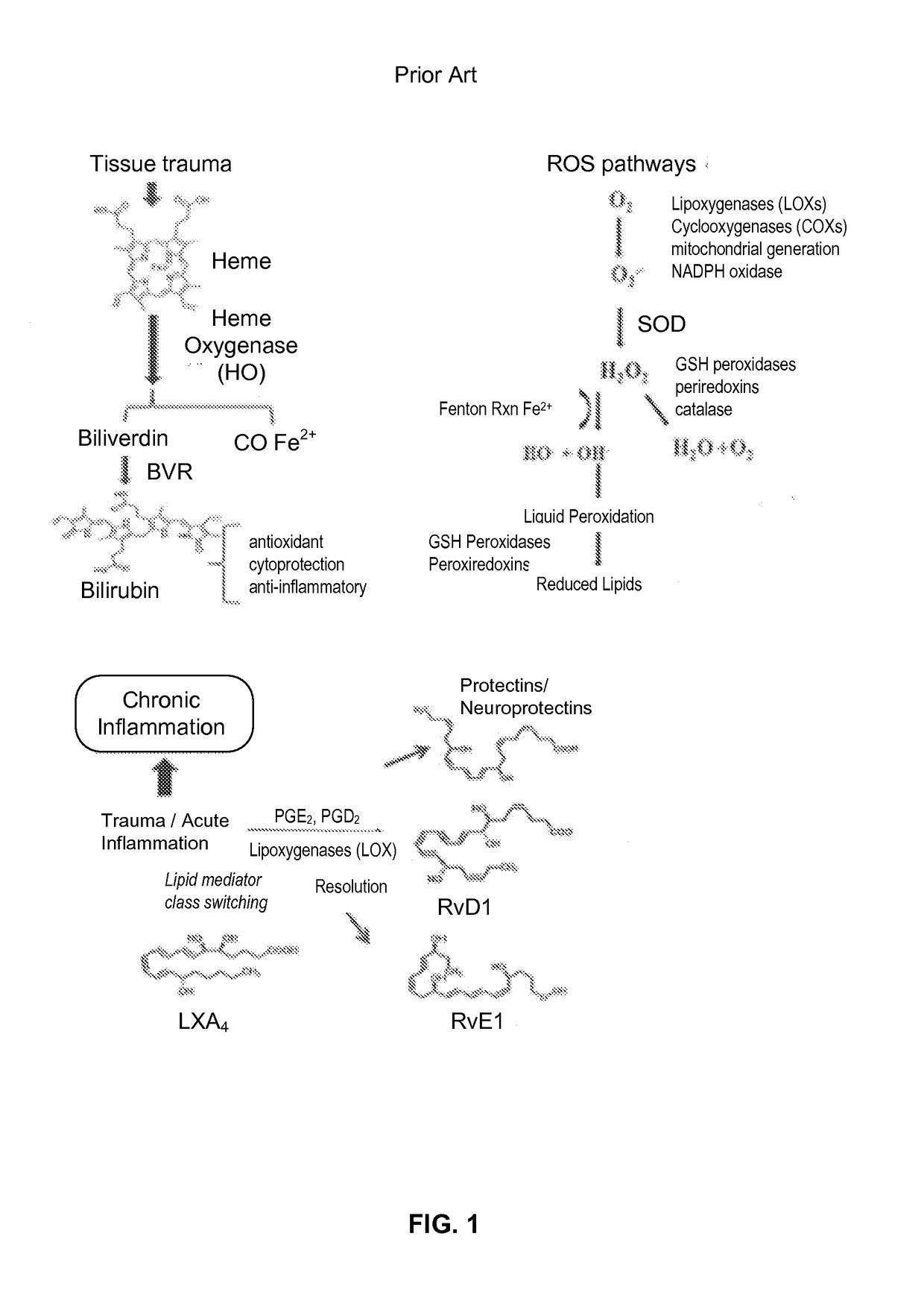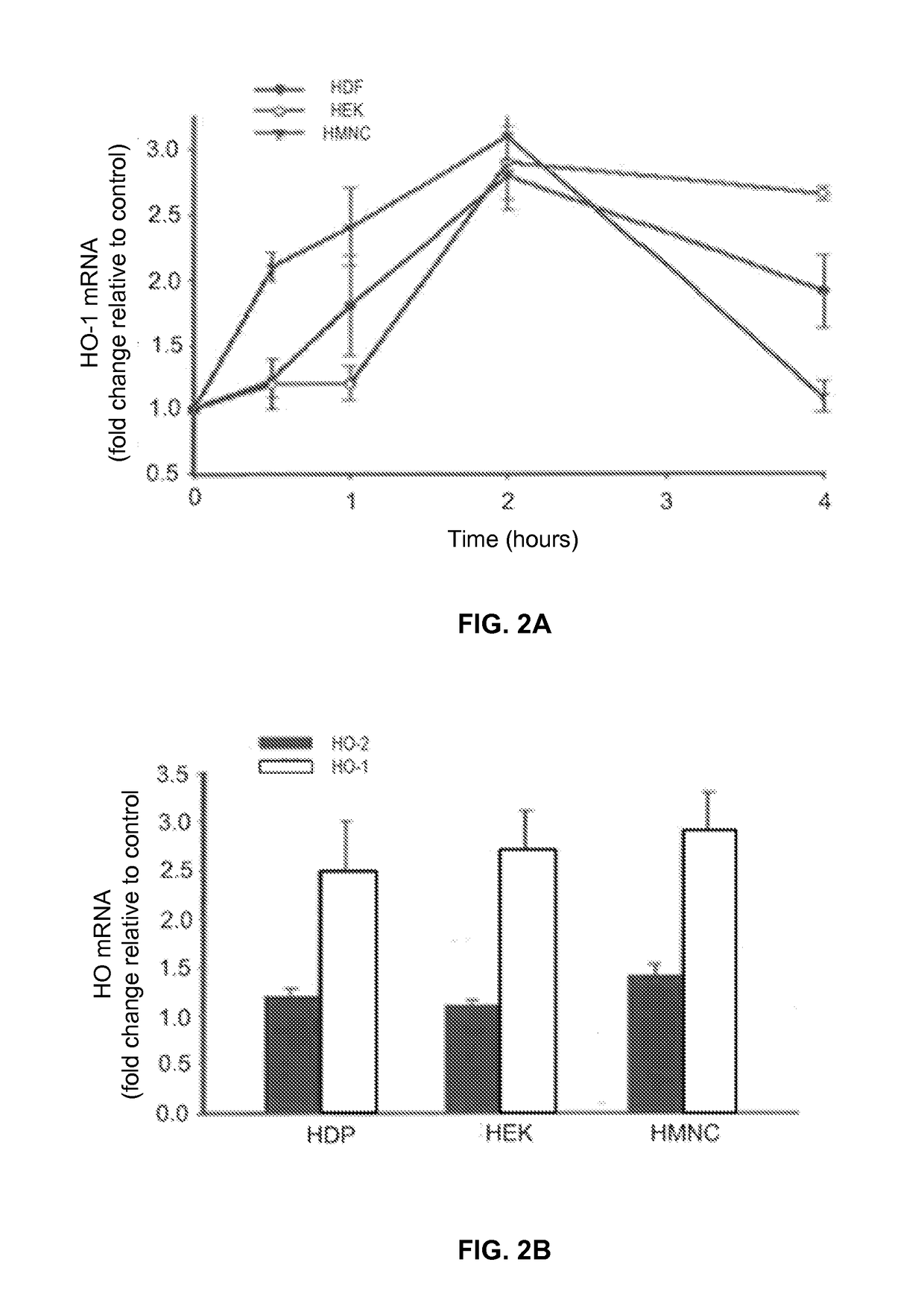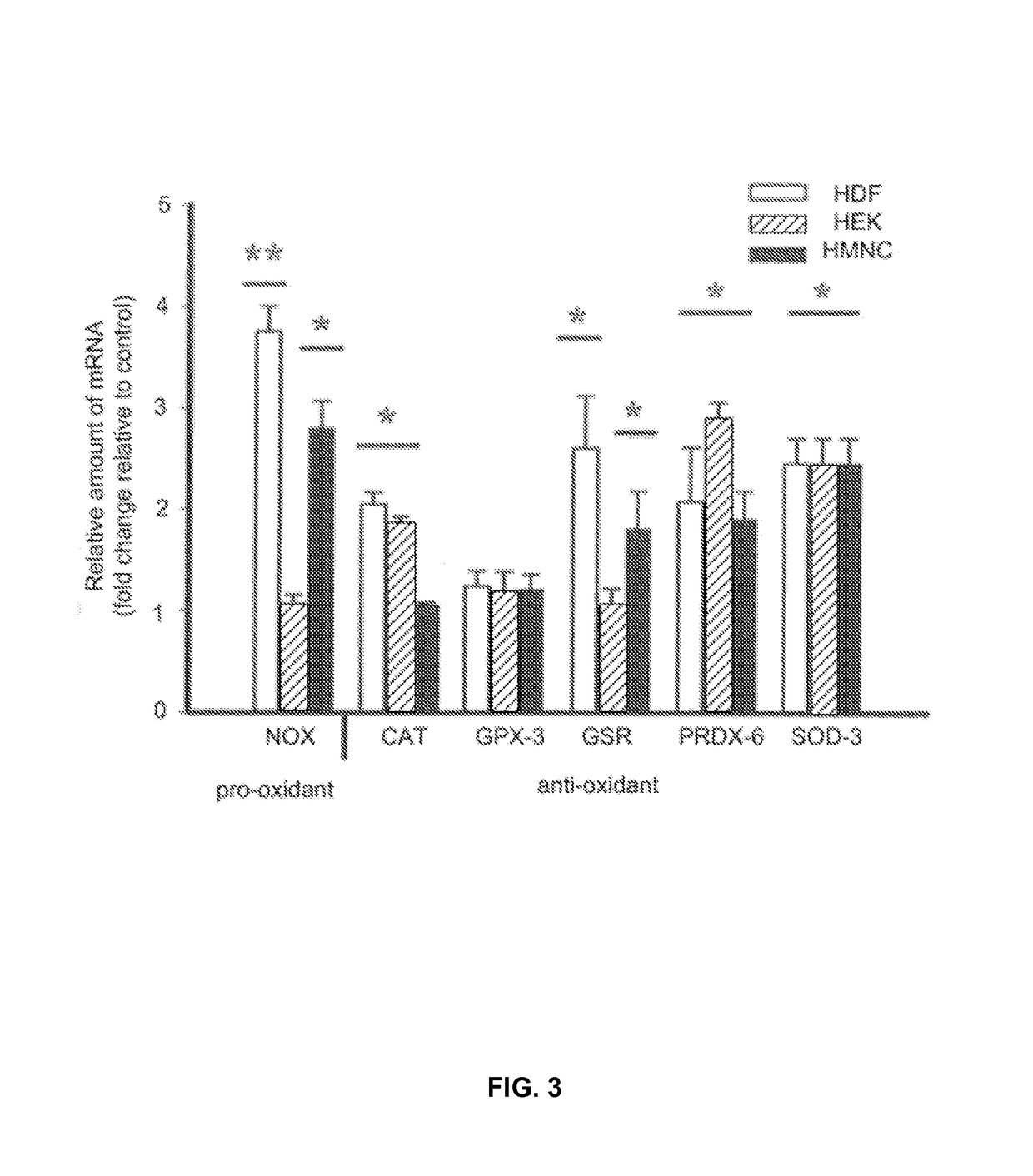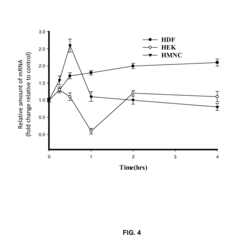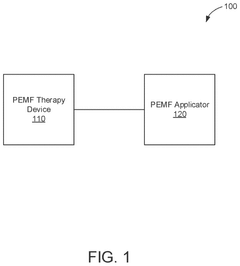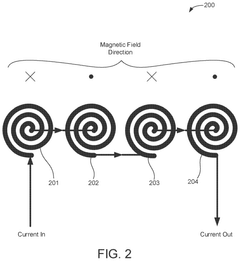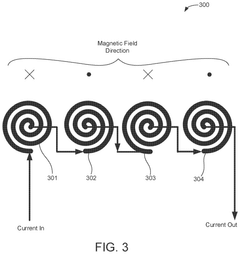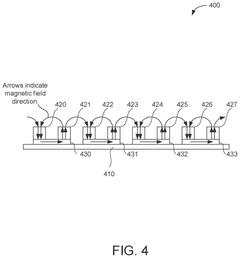How to Utilize PEMF Therapy for Empowered Rehabilitation Outcomes?
AUG 11, 202510 MIN READ
Generate Your Research Report Instantly with AI Agent
Patsnap Eureka helps you evaluate technical feasibility & market potential.
PEMF Therapy Background and Objectives
Pulsed Electromagnetic Field (PEMF) therapy has emerged as a promising non-invasive treatment modality in the field of rehabilitation medicine. This technology harnesses the power of electromagnetic fields to stimulate cellular repair and regeneration, offering potential benefits for a wide range of conditions. The evolution of PEMF therapy can be traced back to the mid-20th century, with significant advancements in recent decades due to improved understanding of cellular biology and electromagnetic interactions.
The primary objective of PEMF therapy in rehabilitation is to enhance the body's natural healing processes, reduce pain and inflammation, and improve overall function. By applying specific electromagnetic frequencies to targeted areas of the body, PEMF therapy aims to accelerate tissue repair, increase blood circulation, and modulate cellular activity. This approach has shown promise in addressing various musculoskeletal disorders, neurological conditions, and chronic pain syndromes.
Recent technological developments have led to more sophisticated PEMF devices, allowing for precise control over field strength, frequency, and waveform. These advancements have expanded the potential applications of PEMF therapy in rehabilitation settings, from post-surgical recovery to chronic disease management. The growing interest in non-pharmacological interventions has further fueled research and development in this field.
One of the key trends in PEMF therapy is the integration of personalized treatment protocols. By tailoring electromagnetic field parameters to individual patient needs, clinicians aim to optimize therapeutic outcomes and minimize potential side effects. This personalized approach aligns with the broader movement towards precision medicine in healthcare.
The global market for PEMF therapy devices has been steadily growing, driven by increasing awareness of its potential benefits and a rising demand for alternative treatment options. However, despite promising clinical results, the widespread adoption of PEMF therapy faces challenges related to standardization of protocols, long-term efficacy data, and regulatory approval processes in various countries.
As research in this field continues to evolve, the objectives for PEMF therapy in rehabilitation are multifaceted. These include expanding the evidence base through rigorous clinical trials, developing more targeted and efficient treatment protocols, and exploring synergies with other rehabilitation modalities. Additionally, there is a focus on improving the accessibility and user-friendliness of PEMF devices to facilitate their integration into both clinical and home-based rehabilitation programs.
The primary objective of PEMF therapy in rehabilitation is to enhance the body's natural healing processes, reduce pain and inflammation, and improve overall function. By applying specific electromagnetic frequencies to targeted areas of the body, PEMF therapy aims to accelerate tissue repair, increase blood circulation, and modulate cellular activity. This approach has shown promise in addressing various musculoskeletal disorders, neurological conditions, and chronic pain syndromes.
Recent technological developments have led to more sophisticated PEMF devices, allowing for precise control over field strength, frequency, and waveform. These advancements have expanded the potential applications of PEMF therapy in rehabilitation settings, from post-surgical recovery to chronic disease management. The growing interest in non-pharmacological interventions has further fueled research and development in this field.
One of the key trends in PEMF therapy is the integration of personalized treatment protocols. By tailoring electromagnetic field parameters to individual patient needs, clinicians aim to optimize therapeutic outcomes and minimize potential side effects. This personalized approach aligns with the broader movement towards precision medicine in healthcare.
The global market for PEMF therapy devices has been steadily growing, driven by increasing awareness of its potential benefits and a rising demand for alternative treatment options. However, despite promising clinical results, the widespread adoption of PEMF therapy faces challenges related to standardization of protocols, long-term efficacy data, and regulatory approval processes in various countries.
As research in this field continues to evolve, the objectives for PEMF therapy in rehabilitation are multifaceted. These include expanding the evidence base through rigorous clinical trials, developing more targeted and efficient treatment protocols, and exploring synergies with other rehabilitation modalities. Additionally, there is a focus on improving the accessibility and user-friendliness of PEMF devices to facilitate their integration into both clinical and home-based rehabilitation programs.
Rehabilitation Market Demand Analysis
The rehabilitation market has witnessed significant growth in recent years, driven by an aging population, increasing prevalence of chronic diseases, and rising awareness of the importance of rehabilitation in improving quality of life. PEMF (Pulsed Electromagnetic Field) therapy has emerged as a promising technology in this sector, offering potential for enhanced rehabilitation outcomes.
Market analysis indicates a robust demand for innovative rehabilitation solutions, with the global rehabilitation equipment market projected to reach substantial growth in the coming years. This growth is fueled by factors such as the rising incidence of disabilities, sports injuries, and the need for post-operative care. PEMF therapy, with its non-invasive nature and potential to accelerate healing processes, is well-positioned to address these market needs.
The demand for PEMF therapy in rehabilitation is particularly strong in developed countries with advanced healthcare systems. North America and Europe lead in adoption, driven by higher healthcare expenditure and greater acceptance of alternative therapies. However, emerging economies in Asia-Pacific and Latin America are showing increasing interest, presenting significant growth opportunities.
Within the rehabilitation market, PEMF therapy finds applications across various segments. Orthopedic rehabilitation, particularly for conditions like osteoarthritis and fracture healing, shows high demand. Neurological rehabilitation, including treatment for conditions such as multiple sclerosis and Parkinson's disease, is another area where PEMF therapy is gaining traction. Sports medicine represents a growing segment, with athletes and sports professionals seeking advanced recovery methods.
The market demand is further bolstered by the shift towards home-based rehabilitation solutions. PEMF devices designed for home use are gaining popularity, aligning with the trend of personalized healthcare and remote patient monitoring. This trend has been accelerated by the recent global health crisis, which has emphasized the need for accessible rehabilitation options outside traditional clinical settings.
Healthcare providers and rehabilitation centers are increasingly recognizing the potential of PEMF therapy to complement traditional rehabilitation techniques. The therapy's ability to potentially reduce pain, improve circulation, and enhance tissue repair aligns well with the goals of comprehensive rehabilitation programs. This recognition is driving demand for PEMF devices in professional healthcare settings.
Despite the growing demand, challenges remain in market penetration. These include the need for more extensive clinical evidence, regulatory hurdles in some regions, and the initial cost of PEMF devices. However, ongoing research and technological advancements are addressing these challenges, potentially expanding the market further.
In conclusion, the rehabilitation market shows a strong and growing demand for PEMF therapy. The technology's versatility, non-invasive nature, and potential to enhance rehabilitation outcomes position it favorably in this evolving market landscape. As research continues to validate its efficacy and as awareness grows among healthcare professionals and patients, PEMF therapy is poised to play an increasingly significant role in empowering rehabilitation outcomes.
Market analysis indicates a robust demand for innovative rehabilitation solutions, with the global rehabilitation equipment market projected to reach substantial growth in the coming years. This growth is fueled by factors such as the rising incidence of disabilities, sports injuries, and the need for post-operative care. PEMF therapy, with its non-invasive nature and potential to accelerate healing processes, is well-positioned to address these market needs.
The demand for PEMF therapy in rehabilitation is particularly strong in developed countries with advanced healthcare systems. North America and Europe lead in adoption, driven by higher healthcare expenditure and greater acceptance of alternative therapies. However, emerging economies in Asia-Pacific and Latin America are showing increasing interest, presenting significant growth opportunities.
Within the rehabilitation market, PEMF therapy finds applications across various segments. Orthopedic rehabilitation, particularly for conditions like osteoarthritis and fracture healing, shows high demand. Neurological rehabilitation, including treatment for conditions such as multiple sclerosis and Parkinson's disease, is another area where PEMF therapy is gaining traction. Sports medicine represents a growing segment, with athletes and sports professionals seeking advanced recovery methods.
The market demand is further bolstered by the shift towards home-based rehabilitation solutions. PEMF devices designed for home use are gaining popularity, aligning with the trend of personalized healthcare and remote patient monitoring. This trend has been accelerated by the recent global health crisis, which has emphasized the need for accessible rehabilitation options outside traditional clinical settings.
Healthcare providers and rehabilitation centers are increasingly recognizing the potential of PEMF therapy to complement traditional rehabilitation techniques. The therapy's ability to potentially reduce pain, improve circulation, and enhance tissue repair aligns well with the goals of comprehensive rehabilitation programs. This recognition is driving demand for PEMF devices in professional healthcare settings.
Despite the growing demand, challenges remain in market penetration. These include the need for more extensive clinical evidence, regulatory hurdles in some regions, and the initial cost of PEMF devices. However, ongoing research and technological advancements are addressing these challenges, potentially expanding the market further.
In conclusion, the rehabilitation market shows a strong and growing demand for PEMF therapy. The technology's versatility, non-invasive nature, and potential to enhance rehabilitation outcomes position it favorably in this evolving market landscape. As research continues to validate its efficacy and as awareness grows among healthcare professionals and patients, PEMF therapy is poised to play an increasingly significant role in empowering rehabilitation outcomes.
PEMF Technology Status and Challenges
Pulsed Electromagnetic Field (PEMF) therapy has gained significant attention in recent years as a promising rehabilitation technique. However, the current status and challenges of PEMF technology reveal a complex landscape of advancements and obstacles.
Globally, PEMF technology has made substantial progress in terms of device miniaturization, improved energy efficiency, and enhanced precision in field generation. Leading research institutions and medical device manufacturers have developed more sophisticated PEMF devices capable of delivering targeted electromagnetic pulses with greater accuracy. These advancements have expanded the potential applications of PEMF therapy in various rehabilitation scenarios.
Despite these improvements, several technical challenges persist. One major hurdle is the optimization of PEMF parameters for specific rehabilitation outcomes. The optimal frequency, intensity, and duration of PEMF exposure vary depending on the targeted condition and individual patient characteristics. Researchers are still working to establish standardized protocols for different rehabilitation needs, which is crucial for widespread clinical adoption.
Another significant challenge lies in the development of more personalized PEMF treatments. Current devices often employ a one-size-fits-all approach, which may limit their effectiveness across diverse patient populations. The integration of artificial intelligence and machine learning algorithms to tailor PEMF treatments based on real-time patient data and feedback remains an active area of research and development.
The miniaturization of PEMF devices for home use and wearable applications presents both opportunities and challenges. While smaller, portable devices increase accessibility and treatment compliance, they often face limitations in power output and field penetration depth. Balancing these factors without compromising therapeutic efficacy is an ongoing technical challenge.
Regulatory hurdles also play a significant role in shaping the PEMF technology landscape. Varying approval processes and standards across different countries can impede the global adoption of new PEMF devices and therapies. Manufacturers and researchers must navigate complex regulatory environments to bring innovative PEMF solutions to market.
From a geographical perspective, PEMF technology development is concentrated in North America, Europe, and parts of Asia, particularly Japan and South Korea. These regions lead in research output, patent filings, and commercial device production. However, there is a growing interest in PEMF technology in emerging markets, which may lead to a more diverse global distribution of innovation in the coming years.
In conclusion, while PEMF technology has made significant strides in enhancing rehabilitation outcomes, it faces multifaceted challenges that require continued research and development efforts. Overcoming these obstacles will be crucial for realizing the full potential of PEMF therapy in empowered rehabilitation.
Globally, PEMF technology has made substantial progress in terms of device miniaturization, improved energy efficiency, and enhanced precision in field generation. Leading research institutions and medical device manufacturers have developed more sophisticated PEMF devices capable of delivering targeted electromagnetic pulses with greater accuracy. These advancements have expanded the potential applications of PEMF therapy in various rehabilitation scenarios.
Despite these improvements, several technical challenges persist. One major hurdle is the optimization of PEMF parameters for specific rehabilitation outcomes. The optimal frequency, intensity, and duration of PEMF exposure vary depending on the targeted condition and individual patient characteristics. Researchers are still working to establish standardized protocols for different rehabilitation needs, which is crucial for widespread clinical adoption.
Another significant challenge lies in the development of more personalized PEMF treatments. Current devices often employ a one-size-fits-all approach, which may limit their effectiveness across diverse patient populations. The integration of artificial intelligence and machine learning algorithms to tailor PEMF treatments based on real-time patient data and feedback remains an active area of research and development.
The miniaturization of PEMF devices for home use and wearable applications presents both opportunities and challenges. While smaller, portable devices increase accessibility and treatment compliance, they often face limitations in power output and field penetration depth. Balancing these factors without compromising therapeutic efficacy is an ongoing technical challenge.
Regulatory hurdles also play a significant role in shaping the PEMF technology landscape. Varying approval processes and standards across different countries can impede the global adoption of new PEMF devices and therapies. Manufacturers and researchers must navigate complex regulatory environments to bring innovative PEMF solutions to market.
From a geographical perspective, PEMF technology development is concentrated in North America, Europe, and parts of Asia, particularly Japan and South Korea. These regions lead in research output, patent filings, and commercial device production. However, there is a growing interest in PEMF technology in emerging markets, which may lead to a more diverse global distribution of innovation in the coming years.
In conclusion, while PEMF technology has made significant strides in enhancing rehabilitation outcomes, it faces multifaceted challenges that require continued research and development efforts. Overcoming these obstacles will be crucial for realizing the full potential of PEMF therapy in empowered rehabilitation.
Current PEMF Rehabilitation Protocols
01 PEMF therapy for pain management and tissue healing
Pulsed Electromagnetic Field (PEMF) therapy is used in rehabilitation to manage pain and promote tissue healing. The therapy applies electromagnetic fields to injured areas, stimulating cellular repair processes and reducing inflammation. This non-invasive treatment can be effective for various conditions, including musculoskeletal injuries and chronic pain syndromes.- PEMF therapy for pain management and tissue healing: Pulsed Electromagnetic Field (PEMF) therapy is used in rehabilitation to manage pain and promote tissue healing. The therapy applies electromagnetic fields to injured areas, stimulating cellular repair processes and reducing inflammation. This non-invasive treatment can be effective for various conditions, including musculoskeletal injuries and chronic pain syndromes.
- PEMF devices for neurological rehabilitation: PEMF therapy shows promise in neurological rehabilitation, particularly for conditions such as stroke recovery and neurodegenerative disorders. The electromagnetic fields are thought to stimulate neural plasticity and improve brain function. Specialized PEMF devices are designed to target specific areas of the brain or nervous system to enhance rehabilitation outcomes.
- Combination of PEMF with other rehabilitation techniques: Integrating PEMF therapy with other rehabilitation techniques can enhance overall treatment outcomes. This may include combining PEMF with physical therapy exercises, occupational therapy, or other modalities such as heat therapy or ultrasound. The synergistic effect of these combined approaches can lead to improved functional recovery and faster rehabilitation progress.
- Portable PEMF devices for home-based rehabilitation: The development of portable PEMF devices allows for home-based rehabilitation, increasing accessibility and treatment frequency. These devices are designed for ease of use, enabling patients to continue their therapy outside of clinical settings. Home-based PEMF therapy can support long-term rehabilitation goals and maintain treatment consistency.
- PEMF therapy for sports injury rehabilitation: PEMF therapy is increasingly used in sports medicine for the rehabilitation of athletic injuries. The treatment can accelerate healing of soft tissue injuries, reduce recovery time, and improve overall performance. PEMF devices designed specifically for sports rehabilitation may offer targeted programs for different types of injuries and body parts.
02 PEMF devices for neurological rehabilitation
PEMF therapy is utilized in neurological rehabilitation to improve nerve function and promote recovery in conditions such as stroke, spinal cord injuries, and neurodegenerative disorders. The electromagnetic fields generated by PEMF devices can stimulate neural plasticity, enhance nerve conduction, and support the regeneration of damaged neural tissues.Expand Specific Solutions03 Combination of PEMF with other rehabilitation techniques
PEMF therapy is often combined with other rehabilitation techniques to enhance overall treatment outcomes. This may include integration with physical therapy exercises, cognitive rehabilitation programs, or other complementary therapies. The synergistic approach can lead to improved functional recovery and faster rehabilitation progress.Expand Specific Solutions04 Portable PEMF devices for home-based rehabilitation
Advancements in PEMF technology have led to the development of portable devices that allow patients to continue their rehabilitation at home. These devices are designed for ease of use and can be programmed to deliver specific treatment protocols. Home-based PEMF therapy can increase treatment adherence and provide more consistent rehabilitation outcomes.Expand Specific Solutions05 PEMF therapy for sports injury rehabilitation
PEMF therapy is increasingly used in sports medicine for the rehabilitation of athletic injuries. The treatment can accelerate healing of soft tissue injuries, reduce recovery time, and improve overall performance. PEMF devices designed specifically for sports rehabilitation may offer targeted protocols for different types of injuries and athlete-specific needs.Expand Specific Solutions
Key PEMF Device Manufacturers
The PEMF therapy market for rehabilitation is in a growth phase, with increasing adoption and expanding applications. The global market size for PEMF devices is projected to reach several billion dollars by 2025, driven by rising awareness of non-invasive treatment options. Technologically, PEMF therapy is advancing rapidly, with companies like Venus Concept Ltd. and Regenesis Biomedical, Inc. leading innovation in device design and treatment protocols. Established medical technology firms such as Medtronic and emerging players like Galvanize Therapeutics are also contributing to the field's development. Academic institutions like the National University of Singapore and Swiss Federal Institute of Technology are conducting research to further validate and improve PEMF therapies, indicating a maturing but still evolving technological landscape.
Venus Concept Ltd.
Technical Solution: Venus Concept utilizes PEMF therapy in their Venus Pulse device, which combines PEMF with other modalities like radiofrequency and magnetic pulse technology. Their approach focuses on enhancing cellular regeneration and reducing inflammation in soft tissues. The device delivers precise, targeted PEMF pulses to stimulate healing and reduce pain in injured areas. Venus Concept's PEMF technology is designed to penetrate deep into tissues, promoting increased blood flow and oxygenation to accelerate the healing process[1][2].
Strengths: Multi-modal approach combining PEMF with other therapies. Targeted treatment for specific injury sites. Weaknesses: May require multiple sessions for optimal results. Limited to soft tissue injuries.
Regenesis Biomedical, Inc.
Technical Solution: Regenesis Biomedical has developed the Provant Therapy System, a PEMF device specifically designed for post-operative pain and edema management. Their technology utilizes a proprietary pulsed radiofrequency energy (PRFE) waveform that mimics the body's natural electrical signals. The Provant system delivers non-thermal electromagnetic energy to the treatment area, stimulating cellular activity and promoting the body's natural healing processes. Clinical studies have shown significant pain reduction and improved range of motion in patients using this technology for rehabilitation[3][4].
Strengths: FDA-cleared for post-operative use. Non-invasive and drug-free treatment option. Weaknesses: Limited to specific indications. May not be suitable for all types of injuries or conditions.
PEMF Mechanism of Action Research
Treatment of conditions susceptible to pulsed electromagnetic field therapy
PatentActiveUS20170354830A1
Innovation
- PEMF therapy is administered to modulate gene expression associated with inflammation pathways, including heme oxygenase, antioxidant enzymes, lipid mediator biosynthesis, and cytokines, using specific parameters such as electric field strength, pulse rate, and duration to produce measurable clinical effects on pain, nerve function, and wound healing.
Method and apparatus for providing pulsed electromagnetic field therapy
PatentPendingUS20240278031A1
Innovation
- The development of PEMF therapy applicators that include multiple PEMF emitter coils arranged to direct magnetic fields uniformly and additional therapy pads for providing heating, cooling, or transcutaneous electrical nerve stimulation (TENS) therapies, with a ferromagnetic field director to enhance magnetic field strength and a substrate that can conform to body parts, allowing for directed and intensified magnetic field application.
Clinical Evidence and Efficacy
Pulsed Electromagnetic Field (PEMF) therapy has garnered significant attention in the field of rehabilitation medicine due to its potential to enhance recovery outcomes. A growing body of clinical evidence supports the efficacy of PEMF therapy across various rehabilitation scenarios, demonstrating its ability to accelerate healing processes and improve patient outcomes.
Multiple randomized controlled trials have shown that PEMF therapy can effectively reduce pain and inflammation in patients with osteoarthritis. A meta-analysis of 14 studies involving over 900 patients revealed that PEMF treatment significantly decreased pain intensity and improved functional mobility in individuals with knee osteoarthritis. These findings suggest that PEMF therapy could be a valuable non-invasive treatment option for managing chronic joint pain and improving quality of life for arthritis patients.
In the realm of bone healing, PEMF therapy has demonstrated remarkable efficacy. A systematic review of 27 clinical trials found that PEMF stimulation significantly accelerated bone union in cases of delayed union and non-union fractures. The therapy was particularly effective in long bone fractures, with success rates ranging from 67% to 90% across different studies. This evidence supports the integration of PEMF therapy into standard fracture management protocols, potentially reducing healing times and improving patient outcomes.
Neurological rehabilitation has also benefited from PEMF therapy. Studies focusing on stroke recovery have shown promising results, with PEMF treatment leading to improved motor function and reduced spasticity in post-stroke patients. A double-blind, placebo-controlled trial involving 40 chronic stroke patients reported significant improvements in upper limb function and activities of daily living following a 12-week PEMF intervention.
In the field of sports medicine, PEMF therapy has demonstrated efficacy in accelerating recovery from soft tissue injuries. A randomized controlled study on athletes with acute ankle sprains found that those receiving PEMF therapy experienced faster reduction in pain and swelling, and earlier return to sports activities compared to the control group. This suggests that PEMF could be a valuable tool in sports rehabilitation programs, potentially shortening recovery times for athletes.
The clinical evidence supporting PEMF therapy extends to chronic wound healing as well. A multicenter study involving 32 patients with chronic diabetic foot ulcers reported a 68% complete wound closure rate after 12 weeks of PEMF treatment, compared to 29% in the control group. These findings highlight the potential of PEMF therapy in addressing challenging wound healing scenarios, particularly in diabetic patients.
While the body of evidence supporting PEMF therapy is substantial, it is important to note that optimal treatment parameters and protocols are still being refined for different conditions. Ongoing research continues to explore the most effective frequencies, intensities, and durations of PEMF application for various rehabilitation needs. Nevertheless, the accumulating clinical data strongly supports the integration of PEMF therapy into comprehensive rehabilitation programs to enhance patient outcomes across a wide range of conditions.
Multiple randomized controlled trials have shown that PEMF therapy can effectively reduce pain and inflammation in patients with osteoarthritis. A meta-analysis of 14 studies involving over 900 patients revealed that PEMF treatment significantly decreased pain intensity and improved functional mobility in individuals with knee osteoarthritis. These findings suggest that PEMF therapy could be a valuable non-invasive treatment option for managing chronic joint pain and improving quality of life for arthritis patients.
In the realm of bone healing, PEMF therapy has demonstrated remarkable efficacy. A systematic review of 27 clinical trials found that PEMF stimulation significantly accelerated bone union in cases of delayed union and non-union fractures. The therapy was particularly effective in long bone fractures, with success rates ranging from 67% to 90% across different studies. This evidence supports the integration of PEMF therapy into standard fracture management protocols, potentially reducing healing times and improving patient outcomes.
Neurological rehabilitation has also benefited from PEMF therapy. Studies focusing on stroke recovery have shown promising results, with PEMF treatment leading to improved motor function and reduced spasticity in post-stroke patients. A double-blind, placebo-controlled trial involving 40 chronic stroke patients reported significant improvements in upper limb function and activities of daily living following a 12-week PEMF intervention.
In the field of sports medicine, PEMF therapy has demonstrated efficacy in accelerating recovery from soft tissue injuries. A randomized controlled study on athletes with acute ankle sprains found that those receiving PEMF therapy experienced faster reduction in pain and swelling, and earlier return to sports activities compared to the control group. This suggests that PEMF could be a valuable tool in sports rehabilitation programs, potentially shortening recovery times for athletes.
The clinical evidence supporting PEMF therapy extends to chronic wound healing as well. A multicenter study involving 32 patients with chronic diabetic foot ulcers reported a 68% complete wound closure rate after 12 weeks of PEMF treatment, compared to 29% in the control group. These findings highlight the potential of PEMF therapy in addressing challenging wound healing scenarios, particularly in diabetic patients.
While the body of evidence supporting PEMF therapy is substantial, it is important to note that optimal treatment parameters and protocols are still being refined for different conditions. Ongoing research continues to explore the most effective frequencies, intensities, and durations of PEMF application for various rehabilitation needs. Nevertheless, the accumulating clinical data strongly supports the integration of PEMF therapy into comprehensive rehabilitation programs to enhance patient outcomes across a wide range of conditions.
Regulatory Framework for PEMF Devices
The regulatory framework for PEMF (Pulsed Electromagnetic Field) devices plays a crucial role in ensuring the safety and efficacy of these therapeutic tools in rehabilitation settings. In the United States, the Food and Drug Administration (FDA) oversees the regulation of PEMF devices, classifying them as Class II medical devices. This classification requires manufacturers to submit a 510(k) premarket notification, demonstrating that their device is substantially equivalent to a legally marketed predicate device in terms of safety and effectiveness.
The FDA has established specific guidelines for PEMF devices, including requirements for electromagnetic compatibility, electrical safety, and biocompatibility. Manufacturers must provide clinical data supporting the intended use of their devices and demonstrate compliance with quality system regulations. Additionally, the FDA mandates that PEMF devices be labeled with appropriate warnings and precautions, as well as clear instructions for use.
In the European Union, PEMF devices fall under the Medical Device Regulation (MDR), which came into effect in May 2021. The MDR imposes stricter requirements on manufacturers, including enhanced clinical evidence, post-market surveillance, and traceability. PEMF devices are typically classified as Class IIa medical devices under the MDR, requiring a conformity assessment by a notified body before obtaining CE marking for market access.
Other major markets, such as Japan and China, have their own regulatory frameworks for PEMF devices. In Japan, the Pharmaceuticals and Medical Devices Agency (PMDA) oversees the approval process, while in China, the National Medical Products Administration (NMPA) regulates these devices. Both countries require extensive documentation and clinical evidence for market approval.
Globally, there is a growing trend towards harmonization of regulatory standards for medical devices, including PEMF therapy equipment. The International Medical Device Regulators Forum (IMDRF) is working to promote convergence in regulatory processes across different jurisdictions, which may streamline the approval process for PEMF devices in multiple markets.
As the field of PEMF therapy continues to evolve, regulatory bodies are adapting their frameworks to address emerging technologies and applications. This includes considerations for combination products that integrate PEMF technology with other therapeutic modalities, as well as software-driven PEMF devices that may require additional cybersecurity measures.
Manufacturers and healthcare providers must stay informed about the latest regulatory requirements and updates to ensure compliance and maintain market access for PEMF devices. This ongoing vigilance is essential for leveraging PEMF therapy effectively in rehabilitation settings while prioritizing patient safety and treatment efficacy.
The FDA has established specific guidelines for PEMF devices, including requirements for electromagnetic compatibility, electrical safety, and biocompatibility. Manufacturers must provide clinical data supporting the intended use of their devices and demonstrate compliance with quality system regulations. Additionally, the FDA mandates that PEMF devices be labeled with appropriate warnings and precautions, as well as clear instructions for use.
In the European Union, PEMF devices fall under the Medical Device Regulation (MDR), which came into effect in May 2021. The MDR imposes stricter requirements on manufacturers, including enhanced clinical evidence, post-market surveillance, and traceability. PEMF devices are typically classified as Class IIa medical devices under the MDR, requiring a conformity assessment by a notified body before obtaining CE marking for market access.
Other major markets, such as Japan and China, have their own regulatory frameworks for PEMF devices. In Japan, the Pharmaceuticals and Medical Devices Agency (PMDA) oversees the approval process, while in China, the National Medical Products Administration (NMPA) regulates these devices. Both countries require extensive documentation and clinical evidence for market approval.
Globally, there is a growing trend towards harmonization of regulatory standards for medical devices, including PEMF therapy equipment. The International Medical Device Regulators Forum (IMDRF) is working to promote convergence in regulatory processes across different jurisdictions, which may streamline the approval process for PEMF devices in multiple markets.
As the field of PEMF therapy continues to evolve, regulatory bodies are adapting their frameworks to address emerging technologies and applications. This includes considerations for combination products that integrate PEMF technology with other therapeutic modalities, as well as software-driven PEMF devices that may require additional cybersecurity measures.
Manufacturers and healthcare providers must stay informed about the latest regulatory requirements and updates to ensure compliance and maintain market access for PEMF devices. This ongoing vigilance is essential for leveraging PEMF therapy effectively in rehabilitation settings while prioritizing patient safety and treatment efficacy.
Unlock deeper insights with Patsnap Eureka Quick Research — get a full tech report to explore trends and direct your research. Try now!
Generate Your Research Report Instantly with AI Agent
Supercharge your innovation with Patsnap Eureka AI Agent Platform!
